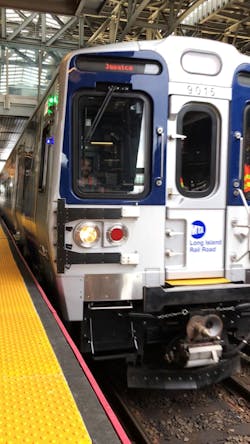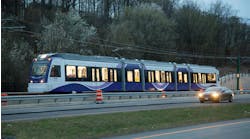LIRR introduces new fleet of rail cars
The Long Island Rail Road (LIRR) has introduced its next fleet of rail cars, the M9 cars, that entered into passenger service on Sept. 11, according to an announcement from LIRR President Phil Eng.
“These new cars will offer new amenities and a better environment for our customers,” Eng said. “Even if your train isn’t composed of these cars, there’s a good chance they will benefit you because as we receive more of them, we will lengthen many of our busiest trains, providing more seats for more customers.”
The fleet will consist of 202 cars, the last of which are expected to begin passenger service in March 2021. The first eight cars are entering service Sept. 11 as the 6:50 a.m. train from Huntington, due into Hunterspoint Avenue at 7:49 a.m. The trainset’s later runs for Sept. 11 are anticipated to be as the 5:06 p.m. train from Penn Station due into Hempstead at 5:57 p.m., and the 10:37 p.m. train from Penn Station, due into Babylon at 11:32 p.m.
The M9 trainset is expected to operate on these same runs on Sept 12. On Sept. 13, LIRR expects to lengthen the trainset to 10 cars and operate it on a different set of trains. The trainset will be lengthened again by two more cars, on Sept. 20, with the resulting 12-car trainset serving yet a different collection of trains throughout the days that follow.
The cars will have exterior destination signs on the front of cars that are visible to passengers as the train approaches the station, similar to the new cars on Metro-North’s New Haven Line. They will have electrical outlets on both sides of the car in each row of seats and closed loop armrests that won’t tear garments or catch bag straps.
The cars will feature a new innovation: an electronic display that will let passengers know what car within the train they are seated (for example, “Car 3 of 10”) which will be of help to customers exiting at stations where not every car will meet the platform.
Walking from car to car will become easier because between every other car there will be a door that operates at the push of a button. The seats in the cars will be slightly wider than the seats on the M7 cars, and the cars will seat more people than the M7 cars, with up to six additional seats in each pair of cars.
The cars are fully equipped for Positive Train Control, a major safety enhancement that will reduce the potential for human error to contribute to train-to-train collisions or derailments. They have cameras in the train engineer’s cab, facing into the cab to monitor the engineer’s alertness and facing forward to show the tracks ahead, and cameras in the passenger area of the cars to serve as a deterrent to criminal activity.
The bathroom experience will have better restroom design that improves cleanliness. There will be no touch needed for flushing the toilet, dispensing sink water and hand soap and drying hands. There are improved restroom doors and coat hooks and additional air quality treatments.
The cars will have additional speakers in the vestibule for clearer public announcements, threshold illuminating lights at the side and end doors, and are anticipated to offer a smoother ride than the M7 cars and reduce sun glare with a slightly increased level of window tint.
The cars are being designed and manufactured by Kawasaki Rail Car, based in Yonkers. The first 14 pilot cars were built in Japan, with these first eight aggressively tested in Pueblo, Colo., before further aggressive testing on the tracks of LIRR. The remaining 188 cars are being manufactured in Lincoln, Nebr., with final assembly taking place in Yonkers.


